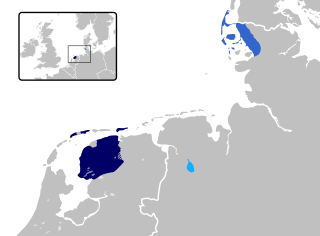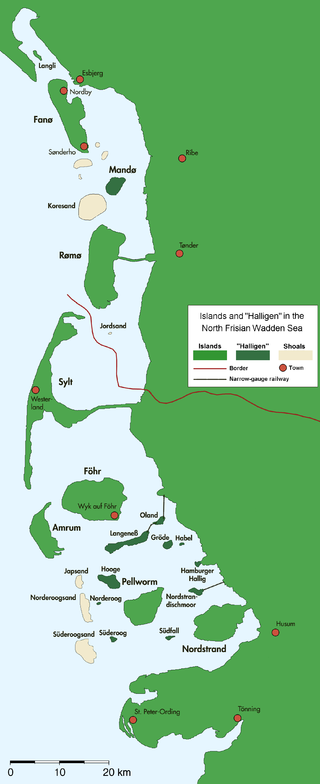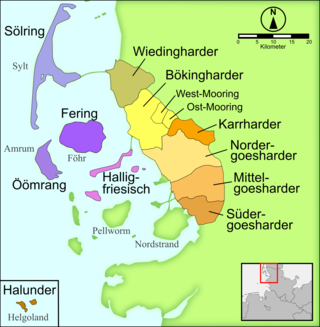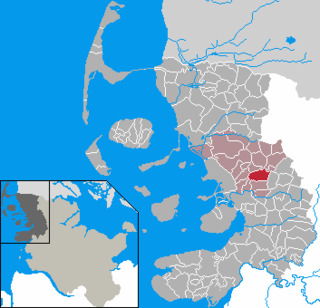
Austrian German, Austrian Standard German (ASG), Standard Austrian German, Austrian High German, or simply just Austrian, is the variety of Standard German written and spoken in Austria and South Tyrol. It has the highest sociolinguistic prestige locally, as it is the variation used in the media and for other formal situations. In less formal situations, Austrians use Bavarian and Alemannic dialects, which are traditionally spoken but rarely written in Austria. It has been standardized with the publishing of the Österreichisches Wörterbuch in 1951.

The Frisian languages are a closely related group of West Germanic languages, spoken by about 400,000 Frisian people, who live on the southern fringes of the North Sea in the Netherlands and Germany. The Frisian languages are the closest living language group to the Anglic languages; the two groups make up the Anglo-Frisian languages group and together with the Low German dialects these form the North Sea Germanic languages. However, modern English and Frisian are not mutually intelligible, nor are Frisian languages intelligible among themselves, owing to independent linguistic innovations and language contact with neighboring languages.

German is a West Germanic language in the Indo-European language family, mainly spoken in Western and Central Europe. It is the most spoken native language within the European Union. It is the most widely spoken and official language in Germany, Austria, Switzerland, Liechtenstein, and the Italian autonomous province of South Tyrol. It is also an official language of Luxembourg, Belgium and the Italian autonomous region of Friuli-Venezia Giulia, as well as a recognized national language in Namibia. There are also notable German-speaking communities in France (Alsace), the Czech Republic, Poland, Slovakia, Denmark, Romania and Hungary (Sopron). Overseas, sizeable communities of German-speakers are found in Brazil, South Africa (Kroondal), Namibia, among others, some communities have decidedly Austrian German or Swiss German characters.

Low Saxon, also known as West Low German are a group of Low German dialects spoken in parts of the Netherlands, northwestern Germany and southern Denmark. It is one of two dialect groups, the other being East Low German.

The North Frisian Islands are the Frisian Islands off the coast of North Frisia.

Frisia is a cross-border cultural region in Northwestern Europe. Stretching along the Wadden Sea, it encompasses the north of the Netherlands and parts of northwestern Germany. Wider definitions of "Frisia" may include the island of Rem and the other Danish Wadden Sea Islands. The region is traditionally inhabited by the Frisians, a West Germanic ethnic group.

The West Germanic languages constitute the largest of the three branches of the Germanic family of languages. The West Germanic branch is classically subdivided into three branches: Ingvaeonic, which includes English, the Low German languages, and the Frisian languages; Istvaeonic, which encompasses Dutch and its close relatives; and Irminonic, which includes German and its close relatives and variants.

East Low German is a group of Low German dialects spoken in north-eastern Germany as well as by minorities in northern Poland. Together with West Low German dialects, it forms a dialect continuum of the Low German language. Before 1945, the dialect was spoken along the entire then-German-settled Baltic Coast from Mecklenburg, through Pomerania, West Prussia into certain villages of the East Prussian Klaipėda Region.

Low German is a West Germanic language spoken mainly in Northern Germany and the northeastern Netherlands. The dialect of Plautdietsch is also spoken in the Russian Mennonite diaspora worldwide.

Saterland Frisian, also known as Sater Frisian, Saterfrisian or Saterlandic, spoken in the Saterland municipality of Lower Saxony in Germany, is the last living dialect of the East Frisian language. It is closely related to the other Frisian languages: North Frisian, spoken in Germany as well, and West Frisian, spoken in the Dutch province of Friesland.

North Frisian is a minority language of Germany, spoken by about 10,000 people in North Frisia. The language is part of the larger group of the West Germanic Frisian languages. The language comprises 10 dialects which are themselves divided into an insular and a mainland group.

German dialects are the various traditional local varieties of the German language. Though varied by region, those of the southern half of Germany beneath the Benrath line are dominated by the geographical spread of the High German consonant shift, and the dialect continuum that connects German to the neighboring varieties of Low Franconian (Dutch) and Frisian.

Hattstedt is a municipality in the district of Nordfriesland, in Schleswig-Holstein, Germany. It is situated near the North Sea coast, approx. 6 km northwest of Husum. Located on the edge of the village is the Mikkelberg-Kunst-und-Cricket Center, a cricket ground which has in the past held neutral Women's One Day Internationals between Denmark Women and the Netherlands Women.

Franconian or Frankish is a collective term traditionally used by linguists to refer to many West Germanic languages, some of which are spoken in what formed the historical core area of Francia during the Early Middle Ages.

Heligolandic (Halunder) is the dialect of the North Frisian language spoken on the German island of Heligoland in the North Sea. It is spoken today by some 500 of the island's 1,650 inhabitants and is also taught in schools. Heligolandic is closely related to the insular North Frisian dialects of Fering and Öömrang because medieval fishery around Heligoland attracted Frisians from Föhr and Amrum, and close contacts have been maintained ever since. In fact Fering and Öömrang are closer in linguistic aspects to the dialect of Heligoland than to that of their neighbouring island Sylt, Söl'ring. Heligolandic also contains a variety of loanwords from 19th-century Modern English due to the 83-year British control of the island.

Halligen Frisian is the dialect of the North Frisian language spoken on the Halligen islands, primarily Langeneß and Hooge, in the German region of North Frisia. The dialect has survived despite the islands' being home to less than 300 people and unprotected by dikes, mandating evacuations during storms. However, it is now in danger of extinction. Although it is spoken on islands, it is considered part of the Mainland North Frisian dialects as opposed to the Insular North Frisian Dialects, due to its linguistic features.

Drelsdorf is a municipality in the district of Nordfriesland, in Schleswig-Holstein, Germany. Drelsdorf is home to the last remaining speakers of the Central Goesharde Frisian dialect of North Frisian.
Dutch dialects and varieties are primarily the dialects and varieties that are both cognate with the Dutch language and spoken in the same language area as the Standard Dutch. They are remarkably diverse and are found within Europe mainly in the Netherlands and northern Belgium.
Strand Frisian was a dialect of the North Frisian language which was originally spoken on Strand island, Duchy of Schleswig. Strand was destroyed in the Burchardi flood of 1634 with its remnants forming the islands Pellworm and Nordstrand which are now part of Germany. Strand Frisian is counted among the mainland group of North Frisian dialects.

Zipser German is a dialect of the German language which developed in the Upper Zips region of what is now northeastern Slovakia among people who settled there from present-day central Germany and the northern Lower Rhine river beginning in the 13th century.
















